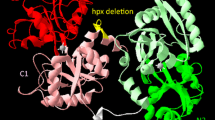Abstract
The effect of repeated parenteral administration of aluminum (Al) was investigated to determine if a relationship exists between the severity of anemia and increase in hepatic heme oxygenase activity. Female Swiss Webster mice were dosed for 11 d with 50 mg Al/kg, as Al lactate, and sodium lactate was given to control mice. On d 12, hematocrit, hemoglobin, blood smears, hepatic heme oxygenase activity, and cytochrome P450 levels were assessed. Significant decreases in hematocrit (39.1±0.7 vs 43.1±0.3% in controls) and hemoglobin (13.1±0.4 vs 14.2±0.2 g/dL in controls) were produced by Al administration. Blood smears from Al-treated mice consistently showed smaller, more irregular red cells. Cytochrome P450 content was significantly decreased (0.443±0.043 vs 0.665±0.055 nmol/mg) whereas hepatic heme oxygenase activity was significantly increased (2.75±0.34 vs 1.66±0.20 nmol/mg/h) in Al-treated animals. The production of mild anemia by parenteral aluminum correlated significantly with the increase in heme oxygenase activity, which, although only 66% greater than in control, preceded a significant loss of cytochrome P450. The increased heme oxygenase activity, with subsequent increased destruction of heme and/or heme proteins is discussed as a possible mechanism for the microcytic, hypochromic anemia associated with Al overload.
Similar content being viewed by others
References
M. R. Wills and J. Savory,Crit. Rev. Clin. Lab. Sci. 27, 59–107 (1989).
J. E. Humphries,Med. Clin. N. Amer. 76, 711–725 (1992).
A. I. K. Short, R. J. Winney, and J. S. Robson,Proc. EDTA 17, 226–233 (1980).
R. D. Swartz, J. Dombrowski, M. Burnatowska-Hledin, and G. H. Mayor,Proc. EDTA-ERA 22, 101–105 (1985).
M. J. Bia, K. Cooper, S. Schnall, T. Duffy, E. Hendler, H. Malluche, and L. Solomon,Kidney Intl. 36, 852–858 (1989).
G. L. Klein,Nutr. Res. Rev. 3, 117–141 (1990).
L. Kaiser, K. A. Schwartz, M. A. Burnatowska-Hledin, and G. H. Mayor,Kidney Intl. 26, 269–274 (1984).
M. Touam, F. Martinez, B. Lacour, R. Bourdon, J. Zingraff, S. DiGiulio, and T. Drüeke,Clin. Nephrol. 19, 295–298 (1983).
R. J. S. McGonigle, and V. Parsons,Nephron 39, 1–9 (1985).
K. Abreo, K. Glass, and M. Sella,Kidney Intl. 37, 677–681 (1990).
S. J. McGregor, M. L. Naves, R. Oria, K. Vass, and J. H. Brock,Biochem. J. 272, 377–382 (1990).
M. D. Maines,FASEB J. 2, 2557–2568 (1988).
R. Stocker,Free Rad. Res. Comm. 9, 101–112 (1990).
E. H. Jeffery, H. T. Jansen, and J. A. Dellinger,Fund. Appl. Toxicol. 8, 541–548 (1987).
G. E. Cartwright,Diagnostic Laboratory Hematology, Grune and Stratton, New York, 1968.
O. H. Lowry, N. J. Rosebrough, A. L. Farr, and R. J. Randall,J. Biol. Chem. 193, 265–276 (1951).
T. Omura and R. Sato,J. Biol. Chem. 239, 2370–2378 (1964).
M. D. Maines, and A. Kappas,J. Biol. Chem. 250, 4171–4177 (1975).
F. B. Seibert and H. G. Wells,Arch. Pathol. 8, 230–262 (1929).
P. A. Meredith, M. R. Moore, and A. Goldberg,Biochem. Soc. Trans. 2, 1243–1245 (1974).
M. Abdulla, S. Sevensson, and B. Haeger-Aronson,Arch. Environ. Health 34, 464–479 (1979).
P. A. Meredith, H. L. Elliott, B. C. Campbell, and M. R. Moore,Toxicol. Lett. 4, 419–424 (1979).
J. P. Buchet, R. Lauwerys, A. Hassoun, M. Dratwa, R. Wens, F. Collart, and C. Tielemans,Nephron 46, 360–363 (1987).
S. S. Buys and J. P. Kushner, inAluminum and Health: a critical review, H. Gitelman, ed., Marcel Dekker, New York, 1989, pp. 235–256.
E. Neiboer and D. H. S. Richardson,Environ. Pollution Series B 1, 3–26 (1980).
J. B. Cannata, C. G. Alonso, M. J. Fernandez-Menendez, I. Soto Fernandez, S. McGregor, P. Menendez-Fraga, and J. H. Brock,Nephrol. Dial. Transplant 6, 637–642 (1991).
J. Mladenovic,J. Clin. Invest. 81, 1661–1665 (1988).
S. J. A. Fatemi, F. H. A. Kadir, and G. R. Moore,Biochem. J. 280, 527–532 (1991).
M. R. Moore, A. Goldberg, and A. A. C. Yeung-Laiwah,Ann. NY Acad. Sci. 514, 191–203 (1987).
G. H. Tait, inHeme and Hemoproteins, F. DeMatteis and W. N. Aldridge, eds., Springer-Verlag, New York, 1978 pp. 1–48.
Author information
Authors and Affiliations
Rights and permissions
About this article
Cite this article
Fulton, B., Jeffery, E.H. Heme oxygenase induction. Biol Trace Elem Res 40, 9–19 (1994). https://doi.org/10.1007/BF02916816
Received:
Accepted:
Issue Date:
DOI: https://doi.org/10.1007/BF02916816




